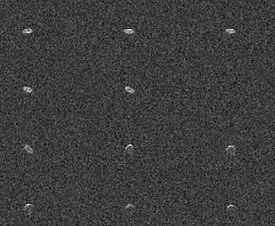4183 Cuno
|
Cuno, imaged by radar | |
| Discovery | |
|---|---|
| Discovered by | Cuno Hoffmeister |
| Discovery date | June 5, 1959 |
| Designations | |
Named after | Cuno Hoffmeister |
| 1959 LM | |
|
Apollo, Mars-crosser, Venus-crosser | |
| Orbital characteristics | |
| Epoch December 1, 2005 (JD 2453705.5) | |
| Aphelion | 485.073 Gm (3.243 AU) |
| Perihelion | 107.872 Gm (0.721 AU) |
| 296.473 Gm (1.982 AU) | |
| Eccentricity | 0.636 |
| 1019.031 d (2.790 a) | |
Average orbital speed | 18.827 km/s |
| 261.969° | |
| Inclination | 6.750° |
| 295.653° | |
| 235.437° | |
| Physical characteristics | |
| Dimensions | 4.5 km |
| 3.6 h | |
Spectral type | Sq |
| 14.4 | |
|
| |
4183 Cuno is an Apollo, Mars- and Venus-crosser asteroid. It was discovered in 1959 by Cuno Hoffmeister, from whom the asteroid takes its name.
Cuno is about 4–9 km in diameter and is an S-type asteroid, meaning that it is highly reflective and composed of nickel-iron mixed with iron- and magnesium-silicates.
In December 2000, Cuno was analysed by radar to determine its shape. The resultant images are lacking in detail, but indicate a rough sphere with some kind of concave depression 1–2 km in diameter.
4183 Cuno approaches the Earth to within 40 Gm six times in the 21st century. On 2012-May-20 Cuno made its closest Earth approach at a distance of 0.12182 AU (18,224,000 km; 11,324,000 mi).[1] It will not make a closer approach until 2093.
References
- ↑ "JPL Close-Approach Data: 4183 Cuno (1959 LM))". Retrieved 2012-06-19.
External links
- 4183 Cuno at the JPL Small-Body Database
| ||||||
| ||||||||||||||||||||||||||||
